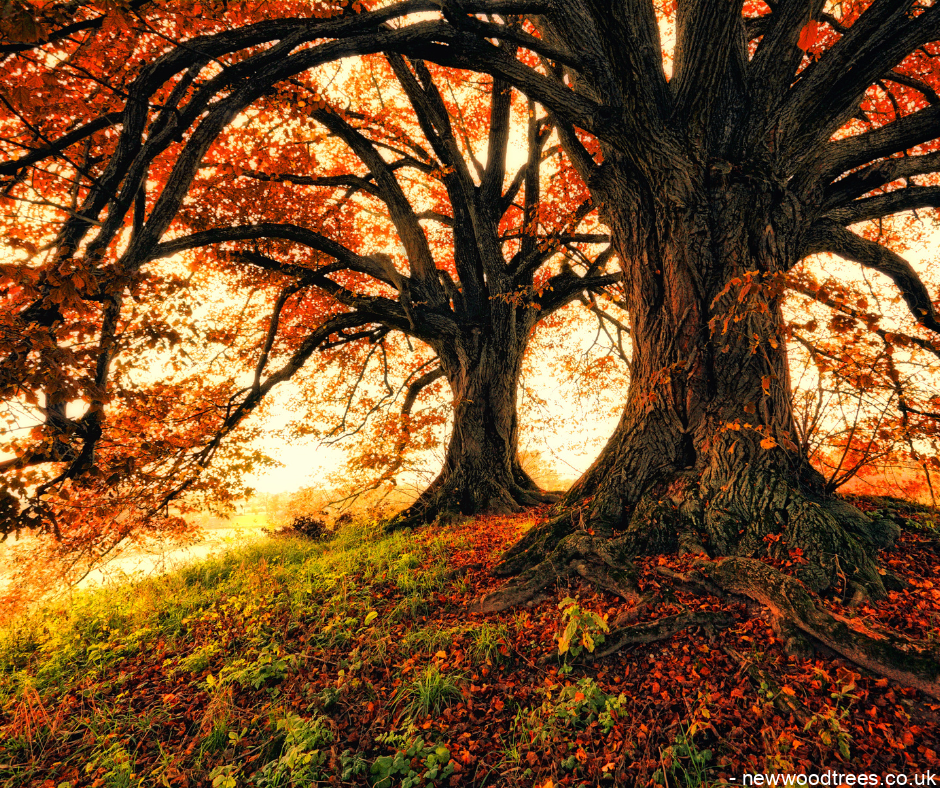Autumn wouldn’t be the same without the crisp leaves that crunch beneath our feet. As they flutter down after a thriving summer, the burnt orange fallen tree leaves gently remind us that that life is fleeting and utterly beautiful. But did you know that only Deciduous trees prepare to part ways with their leaves at this time of year?
Aside from getting family photos at the local pumpkin patch or singing songs around a firepit, this time of year is prime for appreciating the splendour of Mother Nature in the form of autumn trees. Trees with red leaves and those with yellow and burnt orange tones are aesthetically appealing all year round, especially in autumn.
In addition to shade, autumn-planted trees can provide windbreak during winter and sunblock during summer, with some species able to cool the space to 20 degrees.
We’ve got you covered if you are thinking about updating your garden ahead of the autumn months. The deciduous trees mentioned in this article will paint the moist earth in a cosy, leafy blanket during this season.
Benefits of Planting Trees in Autumn
You can take advantage of an additional growing season if you plant trees in autumn. It is advisable to plant trees in autumn because it allows you to nourish the tree before the heat of summer arrives.
Furthermore, by planting trees in autumn, you will have ample opportunity to perfect your techniques in cooler weather conditions. Trees absorb plenty of water; rainfall is usually higher throughout autumn, so you won’t need as much energy watering your trees.
With a steady water supply during autumn, trees can withstand potential droughts during summertime. Declining temperatures also deter diseases and pests, so trees face less risk in autumn. As a result, there will be less need to examine your trees for damage.
Trees with Red Leaves, Orange Hues, and Yellow Tints
During autumn, nature’s ever-changing landscape is comparable to a watercolour painting, largely thanks to the profusion of trees that decorate the landscape. What’s more, the needles and leaves scattering the ground go to good use.
According to the Forest Service, a U.S. Department of Agriculture branch, there is no waste left by the fallen tree components. Instead, they decay and restore the soil with vital nutrients that contribute to the compressible forest floor, which gets its spongy texture from the rainfall.
In addition, various soil organisms that support the forest ecosystem consume fluttering leaves and needles. Why not admire the natural process yourself with some autumn-coloured trees?
Here are a few recommended trees with different autumnal shades:
First on the list is the drought-resistant Freeman Maple, which towers 15-18 metres high and spreads its canopy across 12-15 metres of space. The tree can thrive in most soil types when it is relatively well established.
The ‘Autumn Blaze’ tree is a hybrid mix of two Chicago native trees featuring an expansive oval shape and a sturdy branch structure. This one can withstand chlorosis much better than red or silver maple trees.

Silver Birch gets its name from the bark that peels back on the trunk, exposing creamy white hues that complement its bright green leaves. Betula Pendula grows to 30 metres in height, and during the autumn, its leaves transform into a warm shade of yellow. Silver Birch thrives in locations with cool temperatures.
They commonly bloom in parks and residential gardens but add visual appeal to all landscapes. Plant this medium-sized deciduous tree in moist and well-drained soil for the best results. Recommended soil types include sandy, rocky loam, and acidic soil.

Most tree lovers call this autumn favourite “ginkgo” or “the Maidenhair Tree”. This gymnosperm tree species is one of the oldest surviving species on the planet, believed to date back 290 million years.
The crown spread is irregular, with fan-shaped leaves in shades of green and yellow. Bundles of leaves (usually found in clusters of 3-5) boast distinctive lobes, and the veins extend directly from the stalk.
Yellow fruits appear after catkins, and during the autumn months, the leaves metamorphose to bright yellow. However, the tree must reach an age of 20-50 years before it bears fruit.

Belonging to the Altingiaceae family, Fastigiate Sweetgum stretches to heights of 16-18 metres and 1.5-2 metres across. In summer, the foliage impresses with its deep green hues before metamorphosing to orange, yellow, burgundy, and red during autumn.
You can choose between various soil types when planting the ‘Slender Silhouette’, with clay a popular option. Although this columnar cultivar of the sweet gum is known as a ‘fruitless’ tree, you can also expect to see round fruits during autumn.

Add a rare gem to your garden with the Dawn Redwood, an endangered deciduous tree. First discovered in China sometime in the 1940s amid a plant expedition, palaeontologists used a fossil to trace its origins.
This favoured autumn tree is the last remaining species of the Metasequoia genus. It existed when dinosaurs roamed the earth, and despite being deeply rooted in the planet’s history, it serves well as a modern-day addition to any outdoor project.
Metasequoia glyptostroboides grow to 20-30 metres tall and 4-10 metres wide. Leaves are initially green before floating to the ground in shades of reddish-brown.

If you’re looking for an autumn tree that doesn’t require heaps of upkeep and preventative maintenance, you might like the Upright Pin Oak. This disease-resistant tree has deeply lobed leaves with a glossy texture.
Tightly grouped, the leaves feature prominent veins with light green undersides. They open out to form a thick canopy that spans 3 metres across and 15 metres high. In autumn, the leaves turn bronze-red and usually linger on the branches until new buds form in the winter, thrusting them to the ground.

The genetics of the Swamp White Oak (Q. bicolour) and the Fastigiate English Oak (Q. robur f. Fastigiata merges to create this hybrid oak tree, which climbs to heights of 12-15 metres and unfurls its round-lobed leaves 6 metres across.
The leaves are thick and are a deep green colour. Older trees that evolve through autumn appear red or amber-yellow. It resists powdery mildew well, and the oval acorns (the tree’s fruits) grow on stalks varying in length from 3-10 centimetres.

How to Maintain Autumn Trees After Planting
After photosynthesis, trees absorb carbon dioxide and emit the oxygen that we depend on to survive. Considering the significance of trees in everyday life, you must take care of the ones you plant, regardless of the season in which you sow the root ball.
The following tree care and maintenance tips will help you support the health, longevity, and imperviousness of the autumn trees embellishing your landscape:
- Preventative Tree Care
Nurturing your tree starts with preventative care. Early care will influence the tree’s structure, sturdiness, and overall appearance. Stop problems before they start by performing thorough inspections, trimming weak branches, and applying hormone distribution treatments that amplify root health.
- Water Them Regularly
Like humans, trees get thirsty, too! Irrigate trees deeply and slowly soak at least 30 centimetres of soil. A watering timetable will prove helpful in ensuring your tree never misses a drink. If you need more time to water the tree(s) daily, it may be worth consulting an expert to assist you.
- Mulching
Boost the richness of your tree’s soil by applying a mulching layer after watering deeply in the autumn months. This method enhances the visual appeal and helps preserve soil moisture by acting as insulation.
- Prune Prudently
Pruning your trees in early autumn will promote new development for the months ahead. Since the trees are preparing to enter a dormant phase at this time of year, removing dead or damaged branches is wise for fostering new growth in the coming months.
Thanks to the fallen leaves, detecting an underlying disease on tree limbs or erosion on the trunk and roots during autumn will be easier.
- Regular Inspections
When inspecting your tree(s), pay close attention to the branches that connect to the tree trunk to ensure they are not weak or damaged. If the tree appears to be leaning in one direction more than the other, it may have internal structure problems that require professional assistance.
Avoid planting trees near overhead cables and buildings, mainly if the tree has a large spread. If you need more time to conduct an inspection, consider hiring an arborist to examine the tree(s) on your behalf.
Conclusion
Not only can you expect to amplify the aesthetic of your garden(s) with autumn trees, but also, you can anticipate a surge in value of your property.
Researching correctly before buying and planting autumn trees is critically important. Choose the suitable species and set aside adequate time to prepare a maintenance schedule before planting the first root ball. With professional tree services, you can get a helping hand and even feed your knowledge on the ins and outs of tree care.







